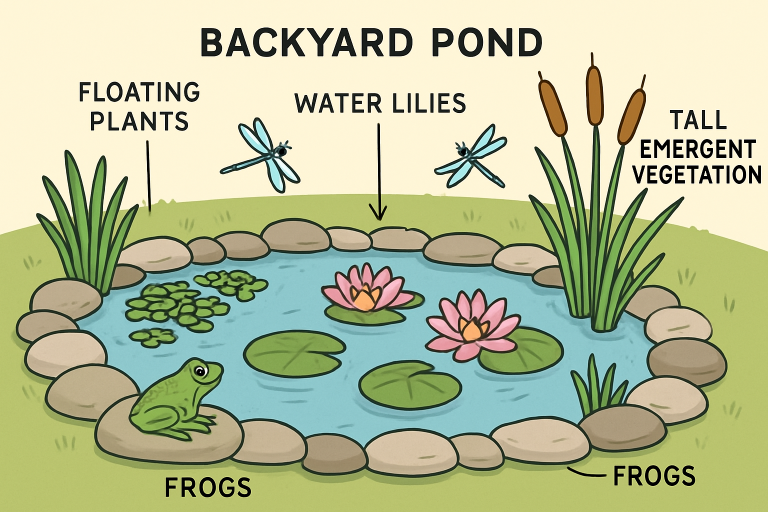Table of Contents
- Choosing Native Aquatic Plants
- Designing with Floating Plants
- Incorporating Emergent Vegetation
- Creating a Balanced Ecosystem
- Seasonal Maintenance Tips
- Enhancing Aesthetics with Hardscaping
- Attracting Wildlife to Your Water Garden
- Conclusion
Transforming your outdoor space into a lush water garden brimming with aquatic plants is both ecologically smart and visually stunning. By blending aesthetics with sustainability, you create a natural oasis that is easy to maintain and supports biodiversity. If you’re exploring ways to maximize the beauty and health of your water features, consider the variety of solutions offered by Aquatic Gardens for tailored aquatic plant integration.
A thoughtful selection of aquatic plants not only beautifies your garden but also boosts local flora and fauna, purifies water, and reduces long-term maintenance. These eco-friendly plant choices offer natural filtration and serve as a tranquil focal point in your landscape design.
Choosing Native Aquatic Plants
Native aquatic plants are a foundational element for any eco-friendly water garden. By selecting species adapted to your local climate and water conditions, you reduce the need for fertilizers, minimize disease risk, and promote a self-sustaining environment. Common choices such as water lilies (Nymphaea odorata), pickerelweed (Pontederia cordata), and arrowhead (Sagittaria latifolia) not only offer vibrant flowers and foliage but also serve as food and shelter for insects, amphibians, and birds. If you’re uncertain about suitable plants for your region, many botanical gardens and local nurseries can provide invaluable guidance.
Designing with Floating Plants
Floating plants offer both practical and decorative benefits, acting as living filters that absorb excess nutrients and block sunlight to hinder algae blooms. Popular options like water lettuce (Pistia stratiotes), water hyacinth (Eichhornia crassipes), and duckweed (Lemna minor) introduce texture and soften the water’s surface. These plants are easy to manage, quickly propagate, and provide essential shade and cover for fish and invertebrates, making them invaluable for maintaining clear, healthy water.
Incorporating Emergent Vegetation
Emergent plants root in the pond bed with stems and leaves that rise above the water’s surface, contributing crucial vertical structure to your garden. Species like cattails (Typha spp.), bulrushes (Schoenoplectus spp.), and soft rush (Juncus effusus) help prevent shoreline erosion, filter runoff, and support pollinator and aquatic life. Beyond their ecological value, emergent plants add a striking visual dimension and seasonal variety to your garden scheme.

Creating a Balanced Ecosystem
A thriving water garden mimics nature by balancing varied plant types with animal life and beneficial microbes. Combining submerged plants (like hornwort or anacharis) with floaters and emergents encourages oxygen production, maintains water clarity, and provides habitats for all life stages of aquatic creatures. Proper planting density is essential—too few plants can lead to poor water quality, but overcrowding may block light and limit growth. If introducing fish, choose native species and avoid overstocking, as this can disrupt the ecosystem.
Seasonal Maintenance Tips
Spring
Clear out accumulated debris, trim dead plant material, and divide or repot overgrown species. Monitor for returning wildlife and prepare for increased plant growth.
Summer
Check water levels regularly, especially in hot spells. Prune fast-growing plants to maintain balance and skim out excess floating vegetation. Keep algae in check with surface shade or barley straw if needed.
Fall & Winter
Trim back tender or dying foliage, remove fallen leaves using netting, and reduce feeding for any fish present as water temperatures drop. Hardy plants may overwinter naturally; tropicals should be brought indoors.
Enhancing Aesthetics with Hardscaping
The marriage between soft plantings and hard materials can make your water garden feel truly complete. Use rocks, boulders, and gravel around the pond edge to anchor plantings and provide natural hiding places for wildlife. Pathways crafted from stepping stones invite strolls. Add seating areas or small bridges for a peaceful place to rest and observe the aquatic ecosystem in action. Lighting or artful sculptures can further accentuate the space, creating a tranquil nighttime retreat.
Attracting Wildlife to Your Water Garden
Diversity is key to attracting a thriving cast of creatures. A mix of submerged, floating, and emergent plants creates a welcome environment for dragonflies, frogs, turtles, and songbirds, who rely on these ecosystems for nesting and food. Water gardens can also serve as natural mosquito control, as fish and predatory insects keep populations in check. By avoiding chemicals and favoring native plants, you’ll foster a dynamic and resilient habitat that supports local biodiversity.
Conclusion
Crafting a sustainable water garden centered around creative aquatic plant design yields not just a stunning centerpiece, but vital ecological benefits for your whole yard. By choosing native species, blending plant types, and thoughtfully integrating natural and hardscaping elements, you’ll enjoy a tranquil retreat that flourishes for years to come.



No comments:
Post a Comment
I love reading and responding to comments but in order to get my reply you must ensure you are NOT a no-reply blogger. If you are, here are some quick steps to change that!
1. Go to the home page of your Blogger account.
2. Select the drop down beside your name on the top right corner and choose Blogger Profile.
3. Select Edit Profile at the top right.
4. Select the Show My Email Address box.
5. Hit Save Profile.